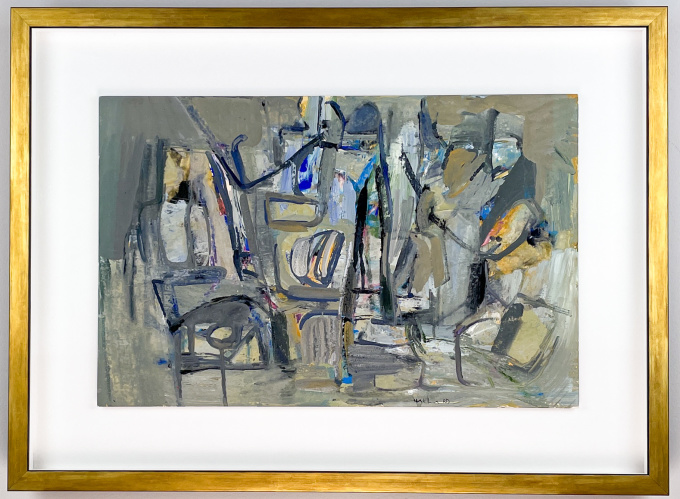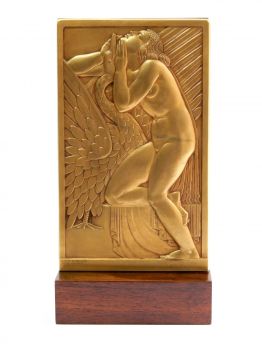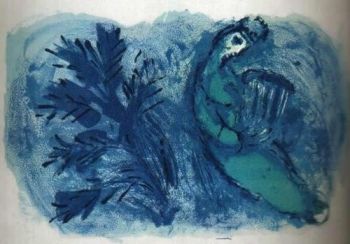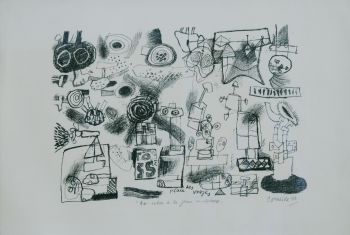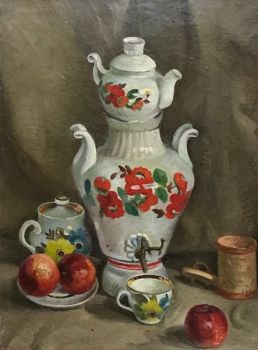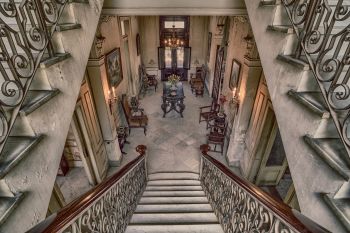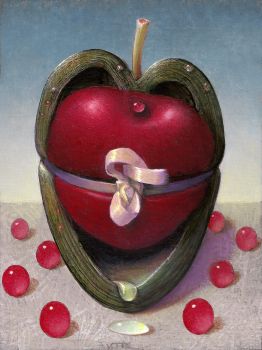“Interior”, circa 1955 – Tempera on cardboard 1950 - 1959
Louis Nallard
TemperaFarbe
49 ⨯ 66 ⨯ 4 cm
ConditionVery good
€ 2.250
Van Kerkhoff Art
- Über KunstwerkOriginal artwork by French painter Louis Nallard. In this abstracted Interior the artist blends grey and earthtones with strokes of vibrant blues, orange and green. Signed by the artist, right bottom corner.
About the artist
Louis Nallard (Algiers 1918 – Paris 2016) was a French non-figurative painter of the Nouvelle École de Paris.
Born on June 17, 1918, in Algiers, French Algeria, had a life intertwined with art and creativity. Despite facing early hardships with the loss of his mother to the Spanish flu, Nallard found solace in his ancestral landscapes. Every summer, he returned to the Dombes region, his father’s birthplace, which became a wellspring of inspiration for his artistic endeavors.
At the tender age of sixteen, in 1934, Nallard unveiled his debut exhibition featuring portraits and landscapes, showcasing his skills in watercolors and gouaches. The exhibition took place at the gallery owned by Thomas Rouault, the nephew of the renowned painter.
In 1941, Nallard enrolled at the Beaux-arts in Algiers, where he encountered fellow artists such as Marcel Fiorini and Robert Lavergne. Lavergne later became his introducer at the prestigious Galerie Jeanne Bucher. During this time, Nallard also met Maria Manton, whom he married in 1944. Additionally, he formed a lasting friendship with the painter Georges Ladrey, who shared his fascination with the work of Pierre Bonnard.
In 1947, Louis Nallard and Maria Manton departed Algiers, accompanied by Fiorini, and relocated to the Paris region. This relocation marked a turning point as they discovered the artistry of Bissière and forged friendships with him and Chastel. From 1948 onwards, Nallard actively participated in group exhibitions at renowned venues such as the Salon des Réalités Nouvelles and the Salon de Mai. Moreover, he established significant connections with the Galerie Jeanne Bucher, which consistently exhibited his paintings from 1948 onwards.
Establishing themselves in the heart of Paris, Nallard and Maria Manton assumed management of the Hôtel du Vieux-Colombier near Saint-Germain-des-Prés in 1950. The hotel became a vibrant hub frequented by artists after their exhibitions. Noteworthy figures such as Serge Poliakoff, who earned a living playing the balalaika in Russian restaurants, Herman Braun-Vega, a recent arrival from Peru, Sidney Bechet, Robert Hossein, the sculptor César, and writers Jean Sénac and Kateb Yacine, occupied its premises. In 1950, Nallard’s talent was recognized when he received the prestigious Prix Fénéon. Three years later, Nallard and Maria Manton exhibited their works in Algiers alongside Jean Sénac, Baya, Bouqueton, and Jean de Maisonseul. Additionally, Robert Martin’s “Colline” gallery in Oran organized an exhibition that showcased Nallard’s paintings alongside those of Bouqueton. It was during this time that Albert Camus took notice of Nallard’s captivating artwork.
The Galerie Jeanne Bucher held its inaugural exhibition of Nallard’s works in 1957, marking the beginning of a longstanding partnership. The following year, Nallard was among the “Sixteen painters of the young Paris school” featured in the Musée de Poche collection, with a preface by Hubert Juin. Throughout the 1950s, Nallard and Maria Manton fostered connections with Algerian painters, including Guermaz, Issiakhem, and Khadda, and developed a special bond with Benanteur and Aksouh. In 1963, Nallard participated in the “Algerian Painters” exhibition organized in Algiers. The following year, his artwork was showcased at the Musée des Arts Décoratifs in Paris.
In the 1960s, Nallard and Maria Manton embarked on a new venture, running “La Galerie” where they provided a platform for young painters. They also played an instrumental role in the Salon des Réalités Nouvelles, with Maria Manton serving as the general secretary from 1961 to 1995 and Louis Nallard assuming positions as vice-president and later honorary president. As Nallard’s exhibitions continued to captivate audiences both in France and abroad, he joined the École des Beaux-Arts in 1975 as a teacher, a role he held until 1983. Today, Nallard’s remarkable artistic legacy is represented in numerous prestigious museums worldwide, including those in Paris, Grenoble, Algiers, Amsterdam, Budapest, Montreal, Oslo, and Turin.
Signed
Signed front, right lower corner: Nallard
Condition
Good original condition, professionally framed
Provenance
Galerie Blanche, Stockholm
Dimensions
Artwork
Height 31,5 cm
Width 49 cm
Frame
Height 49,5 cm
Width 66,8 cm
Depth 4 cm - Über Künstler
Im Jahr 1934, im zarten Alter von 16 Jahren, stellte Louis Nallard seine künstlerischen Schöpfungen zum ersten Mal der Öffentlichkeit in der Thomas Rouault Gallery/Bookstore vor. Dies war der Beginn einer vielversprechenden Reise in die Welt der Kunst.
Während seiner Zeit als Student an der Ecole des Beaux-Arts in Algier im Jahr 1940 führte ihn das Schicksal in die Gesellschaft namhafter Persönlichkeiten wie Fiorini, Bouqueton, Maria Manton und Bernard Lavergne. Er wusste nicht, dass diese zufälligen Begegnungen eine entscheidende Rolle bei der Gestaltung seines künstlerischen Schicksals spielen würden. Erst 1949 führten ihn diese Verbindungen zu dem einflussreichen Jean-François Jaeger.
Louis Nallard hatte bereits während einer Ausstellung in Algier im Jahr 1941 die anspruchsvolle Aufmerksamkeit von Max-Pol Fouchet auf sich gezogen, was die darauf folgende Anerkennung und Anerkennung vorwegnahm. Im Jahr 1947 traf Nallard die lebensverändernde Entscheidung, Algerien hinter sich zu lassen und in das geschäftige Kunstzentrum Paris zu ziehen. Dieser entscheidende Schritt markierte einen Wendepunkt in seiner künstlerischen Entwicklung.
Sein künstlerischer Stil erfuhr einen Wandel, als er sich an die pulsierende Pariser Kunstszene anpasste. Eine neue Ernsthaftigkeit durchdrang seine Palette und seine Formen nahmen eine fragmentiertere und abstraktere Qualität an. Dieser bedeutende Wandel blieb nicht unbemerkt und zu gegebener Zeit wurde ihm in der angesehenen Drouant-David-Galerie der prestigeträchtige „La Bataille“-Preis verliehen.
Das Jahr 1947 markierte auch einen weiteren entscheidenden Moment auf Nallards Reise, als er in der Drouin Gallery auf die einflussreichen Werke von Bissière traf. Diese Begegnung mit Bissières Oeuvre hinterließ einen unauslöschlichen Eindruck in Nallards künstlerischer Entwicklung.
Kurz nach seiner Ankunft in Paris kreuzten sich die Wege von Louis Nallard und dem aufgeklärten Mentor Roger Chastel. Chastel, Träger des Grand Prix National des Arts im Jahr 1932 und Professor an der renommierten Ecole Nationale Supérieure des Beaux-Arts in Paris, wurde zu einem maßgebenden Einfluss auf Nallards künstlerischem Werdegang. Unter Chastels Anleitung blühte und entwickelte sich Nallards künstlerisches Schaffen weiter und festigte seinen Platz in den Annalen der Kunstgeschichte.
Sind Sie daran interessiert, dieses Kunstwerk zu kaufen?
Artwork details
Related artworks
- 1 - 4 / 24
- 1 - 4 / 24
Jan Sluijters
Original illustration of Sluijters for the book: 'Laura's opstel'1881 - 1957
Preis auf AnfrageKunsthandel Pygmalion
Gijsbertus Jan Sijthoff
Interior scene with a woman doing needlework1890 - 1920
Preis auf AnfrageVan der Aalst Fine Art
Jean-François Rauzier
Planalto - Limited edition of 8 2014 - 2024
Preis auf AnfrageVilla del Arte Galleries
1 - 4 / 24- 1 - 4 / 24
Børge Mogensen
Teak wood “dropleaf” desk – Søborg Møbler, Denmark circa 19551950 - 1960
Preis auf AnfrageVan Kerkhoff Art
1 - 4 / 12

